Oversight
The Water Quality Program within the Bureau of Safety and Environmental Enforcement’s Environmental Compliance Program (ECP) centers on monitoring, enforcing, and improving the offshore energy industry's compliance with water quality standards, pollution prevention and control standards, and pollution prevention regulations. Its goal is to protect coastal and marine waters.
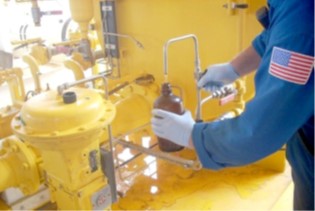
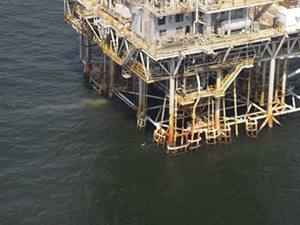
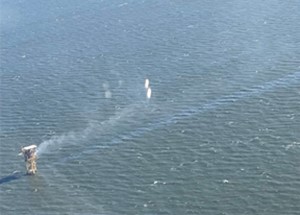
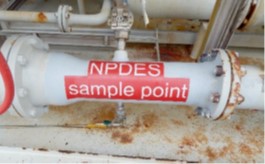
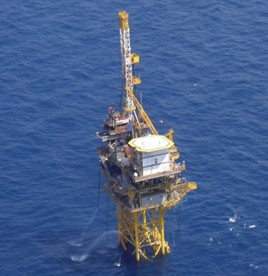
How does BSEE ECP protect water quality?
BSEE’s ECP Water Quality Program works to protects coastal and marine waters by:
- Coordinating with the United States Environmental Protection Agency (EPA) on National Pollutant Discharge Elimination System (NPDES) permit issues and safe drinking water;
- Coordinating with the United States Coast Guard (USCG) on issues involving general pollution prevention, the Act to Prevent Pollution from Ships, oil fingerprinting, and safe drinking water;
- Coordinating with the Bureau of Ocean Energy Management (BOEM) to provide feedback on research and water quality analysis needsOil Rig based on compliance verification and mitigation assessment findings and issues;
- Coordinating with BSEE Regional and District Field Operations Offices who issue permits for drilling, workover/completion, and production operations;
- Conducting field compliance verification and mitigation assessment through offshore site visits; and
- Enforcing non-compliance and ensuring effective corrective action requirements.
How do offshore activities impact water quality?
Discharges during all phases of offshore energy exploration, development, production, and decommissioning operations can impact coastal and marine water quality on the Federal Outer Continental Shelf (OCS). These activities can impact water quality primarily through spills and discharges of pollutants to marine waters. When the water in our oceans becomes polluted, it can endanger wildlife, make our drinking water unsafe, and threaten the waters where we swim and fish.
Water pollutants include produced water, sand, drilling fluids and cuttings, manufactured or processed hydrocarbons, chemicals, sanitary wastes, and deck drainage. Rainwater, fresh water, or sea water mixed with any of these constituents is also considered a pollutant.
Who is responsible for regulating water quality on the Federal OCS?
BSEE, BOEM, the EPA, and the USCG have overlapping jurisdiction over pollution prevention for energy activities on the OCS. BSEE coordinates oversight of water quality on the OCS with these other federal agencies in accordance with a 2021 Memorandum of Understanding (MOU) between the EPA and the Department of the Interior, through a 2012 MOU between the USCG and BSEE, and through associated Memorandums of Agreement (MOAs). ECP is responsible for the compliance verification and enforcement of environmental requirements pertaining to water quality as authorized by OCSLA. ECP engineers, scientists, and other environmental specialists ensure that facilities operating on the OCS are in compliance by conducting water quality field inspections.
What regulations govern water quality on the Federal OCS?
The Outer Continental Shelf Lands Act of 1953 (OSCLA) and subsequent amendments define BSEE’s jurisdiction and regulatory responsibility on Federal offshore lands. It includes specific pollution prevention regulations at 30 C.F.R. Part 250.300 (Subchapter C) – Pollution Prevention and Control. The USCG also has federal responsibilities under OCSLA. The MOUs and MOAs between BSEE and the USCG delineate and facilitate coordination of the activities of the USCG and BSEE in environmental protection.
The Clean Water Act is the principal statute governing pollution control and water quality of the Nation's waterways and is primarily overseen by the USCG and the EPA. It establishes conditions and requires permitting for discharges of pollutants into the waters of the United States under the National Pollutant Discharge Elimination System (NPDES) and gave the EPA the authority to implement pollution control programs such as setting wastewater standards for industry and set water quality standards for all contaminants in surface waters. Regulations governing the NPDES program are contained in 40 C.F.R. Part 122. The current EPA NPDES Permits for the OCS and supporting information can be found on EPA’s Regional websites at:
- EPA Region 4 NPDES General Permit Information for Eastern Gulf of America
- EPA Region 6 NPDES General Permit Information for Western/Central Gulf of America
- EPA Region 9 NPDES General Permit Information for Pacific OCS
- https://www.epa.gov/npdes-permits/alaska-npdes-permitshttps://www.epa.gov/npdes-permits/alaska-npdes-permits
How are pollutant releases or discharges discovered and reported?
The CWA requires all lessees and operators to report any evidence of a sheen or unauthorized release or discharge on the OCS to the National Response Center (NRC). Reporting should be performed by the responsible party, but also may be reported by anyone who notices evidence of a release or discharge such as a sheen. The NRC is an emergency call center manned by the USCG which fields initial reports for pollution incidents and forwards that information to appropriate federal/state agencies for response. BSEE ECP also reviews and tracks pollution reports received from other sources including BSEE District field inspectors, EPA’s 24-hour NPDES non-compliance reports, and NOAA Marine Pollution Monitoring Reports.
What happens after an unauthorized release or discharge is discovered?
The lessee must immediately cease/control the release or discharge and implement corrective action. Corrective actions may range from the shut-in of a single process unit to the shut-in of a total facility. The lessee may only resume operations after it corrects the problem which caused the release or discharge. The lessee must control and remove the pollutant at their own expense and the lessee retains any responsibility for the release or discharge. BSEE ECP promptly refers any verified non-compliant pollution report to the appropriate BSEE office or other federal agency for enforcement action. For example, identified non-compliance with OCSLA and pollution prevention, incident, and control requirements result in Incidents of Non-Compliances (INCs) and ECP will refer the incident for civil and/or criminal penalties within BSEE. BSEE, the EPA, the USCG, or other agency may initiate administrative, civil, or criminal action depending on the circumstances of the release or discharge. If the source of pollution is unknown, the agency may require further action depending on the severity of the incident.
